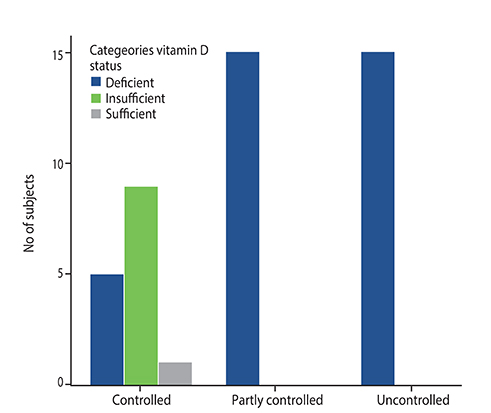Asia Pac Allergy.
2015 Apr;5(2):103-113. 10.5415/apallergy.2015.5.2.103.
Bronchial asthma and hypovitaminosis D in Saudi children
- Affiliations
-
- 1Department of Clinical Biochemistry, Faculty of Medicine, King AbdulAziz University, Jeddah 21483, Saudi Arabia. em_alissa@yahoo.com
- 2Department of Paediatrics, Faculty of Medicine, King AbdulAziz University, Jeddah 21483, Saudi Arabia.
- KMID: 2397057
- DOI: http://doi.org/10.5415/apallergy.2015.5.2.103
Abstract
- BACKGROUND
Asthma, a common lung disease in children, is caused by excessive immune responses to environmental antigens.
OBJECTIVE
Given the immuno-modulatory properties of vitamin D, the aim of the current study was to investigate the relationship between vitamin D levels and markers of asthma severity.
METHODS
This was investigated in a 70 Saudi children with and without asthma and were recruited from the King Abdul Aziz University Hospital, Jeddah, Saudi Arabia, over the period of 11 months (May 2011-April 2012). Childhood asthma control test instrument was employed to assess the level of asthma control among asthmatic patients. Anthropometric measurements were taken and interviewer-administrated questionnaire was completed for all study participants. Pulmonary function test was performed by recording changes in the peak expiratory flow. Venous blood samples were withdrawn for measurements of vitamin D, bone profile, cytokines profile (interleukin-10, tumor necrosis factor-alpha, platelets derived growth factor), and atopy markers (IgE and eosinophil count).
RESULTS
Hypovitaminosis D is highly prevalent among asthmatic children with highly significant increase in several markers of allergy and asthma severity as compared with healthy control children. Significant correlations between several inflammatory and immunological markers and vitamin D levels were also found. Finally, lower 25-hydroxyvitamin D levels were associated with a higher asthma prevalence in multivariable analysis.
CONCLUSION
Our study showed that hypovitaminosis D is highly prevalent in the whole population in addition to a highly significant increase in several markers of allergy and asthma severity among asthmatic children as compared with healthy control children.
Keyword
MeSH Terms
Figure
Cited by 3 articles
-
Vitamin D serum levels and risk of asthma in children
Min Jung You, Woo Kyung Kim
Allergy Asthma Respir Dis. 2016;4(1):44-48. doi: 10.4168/aard.2016.4.1.44.In this issue of Asia Pacific allergy
Constance H. Katelaris
Asia Pac Allergy. 2015;5(2):57-58. doi: 10.5415/apallergy.2015.5.2.57.The role of vitamin D in allergic rhinitis
Hui-Qin Tian, Lei Cheng
Asia Pac Allergy. 2017;7(2):65-73. doi: 10.5415/apallergy.2017.7.2.65.
Reference
-
1. Global Initiative for Asthma (GINA). Global strategy for asthma management and prevention 2010 (updated) [Internet]. The Global Initiative for Asthma;c2011. cited 2014 Jul 1. Available from: http://www.ginasthma.com.2. Akinbami LJ, Moorman JE, Liu X. Asthma prevalence, health care use, and mortality: United States, 2005-2009. Natl Health Stat Report. 2011; (32):1–14.3. Eggleston PA, Rosenstreich D, Lynn H, Gergen P, Baker D, Kattan M, Mortimer KM, Mitchell H, Ownby D, Slavin R, Malveaux F. Relationship of indoor allergen exposure to skin test sensitivity in inner-city children with asthma. J Allergy Clin Immunol. 1998; 102(4 Pt 1):563–570.
Article4. Banerjee A, Damera G, Bhandare R, Gu S, Lopez-Boado Y, Panettieri R Jr, Tliba O. Vitamin D and glucocorticoids differentially modulate chemokine expression in human airway smooth muscle cells. Br J Pharmacol. 2008; 155:84–92.
Article5. Holick MF. Vitamin D deficiency. N Engl J Med. 2007; 357:266–281.
Article6. Sutherland ER, Goleva E, Jackson LP, Stevens AD, Leung DY. Vitamin D levels, lung function, and steroid response in adult asthma. Am J Respir Crit Care Med. 2010; 181:699–704.
Article7. Bener A, Ehlayel MS, Tulic MK, Hamid Q. Vitamin D deficiency as a strong predictor of asthma in children. Int Arch Allergy Immunol. 2012; 157:168–175.
Article8. Ross AC, Manson JE, Abrams SA, Aloia JF, Brannon PM, Clinton SK, Durazo-Arvizu RA, Gallagher JC, Gallo RL, Jones G, Kovacs CS, Mayne ST, Rosen CJ, Shapses SA. The 2011 report on dietary reference intakes for calcium and vitamin D from the Institute of Medicine: what clinicians need to know. J Clin Endocrinol Metab. 2011; 96:53–58.
Article9. Siddiqui AM, Kamfar HZ. Prevalence of vitamin D deficiency rickets in adolescent school girls in Western region, Saudi Arabia. Saudi Med J. 2007; 28:441–444.10. Alissa EM, Qadi SG, Alhujaili NA, Alshehri AM, Ferns GA. Effect of diet and lifestyle factors on bone health in postmenopausal women. J Bone Miner Metab. 2011; 29:725–735.
Article11. Al-Othman A, Al-Musharaf S, Al-Daghri NM, Krishnaswamy S, Yusuf DS, Alkharfy KM, Al-Saleh Y, Al-Attas OS, Alokail MS, Moharram O, Sabico S, Chrousos GP. Effect of physical activity and sun exposure on vitamin D status of Saudi children and adolescents. BMC Pediatr. 2012; 12:92.
Article12. Halbert RJ, Tinkelman DG, Globe DR, Lin SL. Measuring asthma control is the first step to patient management: a literature review. J Asthma. 2009; 46:659–664.
Article13. Alanezi M, Al-Jahdali HH, Al-Hajjaj MS, Zeitoni MO, Al-Tasan TH. Levels of acceptance of Asthma Control Test questionnaire among Saudi patients attending 5 tertiary care hospitals in Saudi Arabia. Saudi Med J. 2009; 30:546–549.14. World Health Organization. Physical status: the use and interpretation of anthropometry. Geneva: World Health Organization;1985. WHO Techincal Report Series 854.15. Standardization of Spirometry, 1994 Update. American Thoracic Society. Am J Respir Crit Care Med. 1995; 152:1107–1136.16. Lips P. Vitamin D deficiency and secondary hyperparathyroidism in the elderly: consequences for bone loss and fractures and therapeutic implications. Endocr Rev. 2001; 22:477–501.
Article17. Al Frayh AR, Shakoor Z, Gad El Rab MO, Hasnain SM. Increased prevalence of asthma in Saudi Arabia. Ann Allergy Asthma Immunol. 2001; 86:292–296.
Article18. Kamfar HZ, Koshak EE. The impact of some demographic factors on the severity of asthma in children. J Family Community Med. 2002; 9:19–24.19. Allan K, Devereux G. Diet and asthma: nutrition implications from prevention to treatment. J Am Diet Assoc. 2011; 111:258–268.
Article20. Litonjua AA, Weiss ST. Is vitamin D deficiency to blame for the asthma epidemic? J Allergy Clin Immunol. 2007; 120:1031–1035.
Article21. Alyasin S, Momen T, Kashef S, Alipour A, Amin R. The relationship between serum 25 hydroxy vitamin d levels and asthma in children. Allergy Asthma Immunol Res. 2011; 3:251–255.
Article22. Chinellato I, Piazza M, Sandri M, Peroni D, Piacentini G, Boner AL. Vitamin D serum levels and markers of asthma control in Italian children. J Pediatr. 2011; 158:437–441.
Article23. Kumar J, Muntner P, Kaskel FJ, Hailpern SM, Melamed ML. Prevalence and associations of 25-hydroxyvitamin D deficiency in US children: NHANES 2001-2004. Pediatrics. 2009; 124:e362–e370.
Article24. Damera G, Fogle HW, Lim P, Goncharova EA, Zhao H, Banerjee A, Tliba O, Krymskaya VP, Panettieri RA Jr. Vitamin D inhibits growth of human airway smooth muscle cells through growth factor-induced phosphorylation of retinoblastoma protein and checkpoint kinase 1. Br J Pharmacol. 2009; 158:1429–1441.
Article25. Brehm JM, Celedon JC, Soto-Quiros ME, Avila L, Hunninghake GM, Forno E, Laskey D, Sylvia JS, Hollis BW, Weiss ST, Litonjua AA. Serum vitamin D levels and markers of severity of childhood asthma in Costa Rica. Am J Respir Crit Care Med. 2009; 179:765–771.
Article26. Camargo CA Jr, Rifas-Shiman SL, Litonjua AA, Rich-Edwards JW, Weiss ST, Gold DR, Kleinman K, Gillman MW. Maternal intake of vitamin D during pregnancy and risk of recurrent wheeze in children at 3 y of age. Am J Clin Nutr. 2007; 85:788–795.
Article27. Rosen CJ, Adams JS, Bikle DD, Black DM, Demay MB, Manson JE, Murad MH, Kovacs CS. The nonskeletal effects of vitamin D: an Endocrine Society scientific statement. Endocr Rev. 2012; 33:456–492.
Article28. Alissa EM, Alnahdi WA, Alama N, Ferns GA. Relationship between vitamin D and cardio-metabolic biomarkers among Saudi postmenopausal women. J Nutr Ther. 2014; 3:18–25.
Article29. Black PN, Scragg R. Relationship between serum 25-hydroxyvitamin d and pulmonary function in the third national health and nutrition examination survey. Chest. 2005; 128:3792–3798.
Article30. Brehm JM, Schuemann B, Fuhlbrigge AL, Hollis BW, Strunk RC, Zeiger RS, Weiss ST, Litonjua AA. Childhood Asthma Management Program Research Group. Serum vitamin D levels and severe asthma exacerbations in the Childhood Asthma Management Program study. J Allergy Clin Immunol. 2010; 126:52–58.e5.
Article31. Searing DA, Leung DY. Vitamin D in atopic dermatitis, asthma and allergic diseases. Immunol Allergy Clin North Am. 2010; 30:397–409.
Article32. Xystrakis E, Kusumakar S, Boswell S, Peek E, Urry Z, Richards DF, Adikibi T, Pridgeon C, Dallman M, Loke TK, Robinson DS, Barrat FJ, O'Garra A, Lavender P, Lee TH, Corrigan C, Hawrylowicz CM. Reversing the defective induction of IL-10-secreting regulatory T cells in glucocorticoid-resistant asthma patients. J Clin Invest. 2006; 116:146–155.
Article33. Searing DA, Zhang Y, Murphy JR, Hauk PJ, Goleva E, Leung DY. Decreased serum vitamin D levels in children with asthma are associated with increased corticosteroid use. J Allergy Clin Immunol. 2010; 125:995–1000.
Article34. von Essen MR, Kongsbak M, Schjerling P, Olgaard K, Odum N, Geisler C. Vitamin D controls T cell antigen receptor signaling and activation of human T cells. Nat Immunol. 2010; 11:344–349.
Article35. Chambers ES, Hawrylowicz CM. The impact of vitamin D on regulatory T cells. Curr Allergy Asthma Rep. 2011; 11:29–36.
Article36. Sharief S, Jariwala S, Kumar J, Muntner P, Melamed ML. Vitamin D levels and food and environmental allergies in the United States: results from the National Health and Nutrition Examination Survey 2005-2006. J Allergy Clin Immunol. 2011; 127:1195–1202.
Article37. Zosky GR, Berry LJ, Elliot JG, James AL, Gorman S, Hart PH. Vitamin D deficiency causes deficits in lung function and alters lung structure. Am J Respir Crit Care Med. 2011; 183:1336–1343.
Article38. Howarth PH, Babu KS, Arshad HS, Lau L, Buckley M, McConnell W, Beckett P, Al Ali M, Chauhan A, Wilson SJ, Reynolds A, Davies DE, Holgate ST. Tumour necrosis factor (TNFalpha) as a novel therapeutic target in symptomatic corticosteroid dependent asthma. Thorax. 2005; 60:1012–1018.39. Poon AH, Laprise C, Lemire M, Montpetit A, Sinnett D, Schurr E, Hudson TJ. Association of vitamin D receptor genetic variants with susceptibility to asthma and atopy. Am J Respir Crit Care Med. 2004; 170:967–973.
Article40. Roth M, Johnson PR, Borger P, Bihl MP, Rudiger JJ, King GG, Ge Q, Hostettler K, Burgess JK, Black JL, Tamm M. Dysfunctional interaction of C/EBPalpha and the glucocorticoid receptor in asthmatic bronchial smooth-muscle cells. N Engl J Med. 2004; 351:560–574.41. Bernardi RJ, Trump DL, Yu WD, McGuire TF, Hershberger PA, Johnson CS. Combination of 1alpha,25-dihydroxyvitamin D(3) with dexamethasone enhances cell cycle arrest and apoptosis: role of nuclear receptor cross-talk and Erk/Akt signaling. Clin Cancer Res. 2001; 7:4164–4173.
- Full Text Links
- Actions
-
Cited
- CITED
-
- Close
- Share
- Similar articles
-
- A clinical study of bronchial asthma in children
- Late asthmatic responses and consequences on nonspecific bronchial reactivity after exercise and allergen challanges in the children with bronchial asthma
- Genetic Factors in Bronchial Asthma
- Relationship between duration of disease and bronchial responsiveness in 6-8 years old children with asthma
- Eosinophil cationic protein in relation to bronchial hyperresponsiveness in asthmatic children





